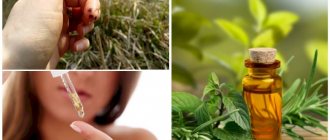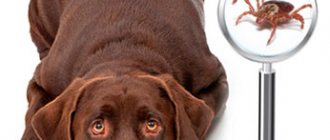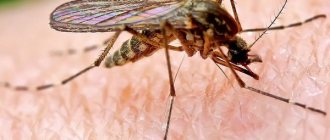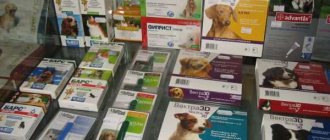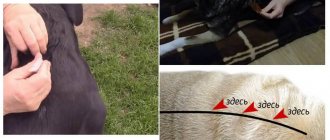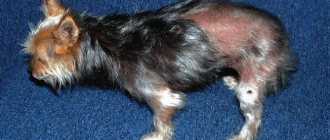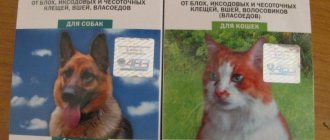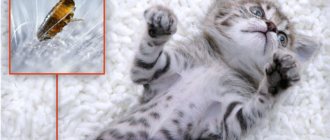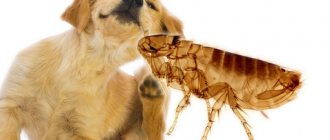The dangers of ticks and fleas for dogs and cats
Ticks and fleas are rightfully considered one of the most unpleasant and dangerous parasites. Your cat or dog can become infected with them anywhere and in any way. For example, small puppies and kittens that have never been outside can pick up parasites from their mother, and an adult animal runs the risk of acquiring them during a walk or even at home if a person accidentally carries them.
Ticks and fleas are carriers of dangerous diseases
The active period of insects is spring and summer. It is at this time that it is very important to take care of tick and flea prevention for your pet. Basically, a cat or dog becomes infected with so-called “dog fleas”, in Latin - Ctenocephalus canis. They are no different from other subspecies: their body is flattened, have three pairs of legs, and feed on the blood and dead skin cells of their host. The shape of the body allows the insect to move freely in the animal’s thick fur, jump from one “master” to another and easily avoid dog or cat claws and teeth. A flea's jump can reach a height of 1 - 1.5 m. To jump onto a potential host, an insect can give itself an incredible acceleration, which is almost 145 times higher than Earth's gravity! Another feature of them is their amazing survivability. Fleas and ticks easily adapt to any, even the most extreme, conditions, resist many insecticides, and also develop immunity to them over time.
How dangerous are ticks and fleas?
The danger of insects is undeniable: in addition to constant and very painful bites, fleas can transmit a variety of diseases and infections with the blood of a previous carrier to the current one. Also, insect bites cause severe itching in the animal, which is why the dog or cat scratches the wound, infecting it again. This can lead to the development of severe allergies or various skin diseases. Fleas are carriers of plague, typhoid, tularemia and other dangerous diseases. They can be the cause of the development of helminthiasis (a disease caused by internal parasites - helminths). The cubs, in addition, are at risk of severe exhaustion and anemia.
Flea bites are painful and cause severe discomfort to the animal.
According to statistics, every second external parasite is a carrier of dangerous infections. Moreover, they are dangerous not only for animals, but also for humans.
Here are just some of the diseases that are carried by fleas and ticks:
- Encephalitis. The carrier is the encephalitis tick. The disease is also called inflammation of the brain and is practically untreatable. People who have suffered this disease remain disabled for life in 90% of cases, and animals die in approximately 80 cases out of 100.
- Piroplasmosis. This disease, although curable, is dangerous due to its consequences. A pet who has suffered piroplasmosis often suffers from weakened joints and liver failure, and complications can follow the animal throughout its life. There is also a high probability that the pet, having suffered the disease, will remain disabled.
- Lyme disease or borreliosis is also dangerous for humans. Vectors are mainly ticks. Pathogens spread throughout all organs, so the entire body suffers: heart, brain, joints, central nervous system. Complications after illness are unpredictable. Joint diseases, heart failure, allergies often develop, and immunity decreases.
Identifying fleas and ticks - main symptoms
Fighting fleas and ticks on pets is possible and necessary! But first you need to find out for sure whether your pet is infected with parasites. Fleas and ticks can be difficult to identify, so it is best to consult an experienced veterinarian. At the very beginning of infection, the animal does not show obvious anxiety. But the further you go, the more noticeable some symptoms become:
Fleas and ticks are quite difficult to detect, so it is necessary to monitor your pet’s well-being and regularly inspect its fur.
- The dog or cat suddenly and noticeably loses weight;
- appetite noticeably decreases;
- the animal suffers from unbearable itching, scratching the bites to the point of bloody wounds;
- even the most affectionate pet becomes much more aggressive and nervous.
But if you are not sure of the symptoms and the opportunity to visit a doctor, then you can examine your pet yourself. You may not notice fleas, but traces of their presence are quite visible. A thorough inspection of the fur will help detect both attached ticks and flea excrement and eggs. The most careful areas to check are the abdomen, intermaxillary space and neck.
The veterinarian told how to protect your dog from ticks
Photo: Moscow 24/Anton Velikzhanin
The President of the Union of Cynological Organizations, veterinarian Vladimir Urazhevsky, in a conversation with Moscow 24, told how pet owners can protect them from ticks. According to the expert, you should use a set of products that protect against dangerous insects.
Urazhevsky believes that ticks are now the most important problem for dog owners. The expert emphasized that the insects themselves are not as dangerous as the diseases they carry. He stated that animal owners need to be extremely careful and pay special attention to walks with their pets, from choosing a walking location to a visual inspection after each visit to the street.
The veterinarian stated that ticks prefer to live in shady areas, in forests, in tall grass with high humidity. “They also need a comfortable environment. If you walk in an open area, the chances of picking up a tick are much less,” the specialist notes.
Urazhevsky clarified that now there are a wide variety of means to protect animals from insect bites, and each case has its own nuances. For example, a flea and tick collar has a strong odor, so after a walk you should remove it and put it in a separate sealed bag. “This way it retains its properties and there is no unpleasant odor,” said the veterinarian.
The expert mentioned drops and sprays against ticks. In his opinion, they also have the desired effect. However, he urged that you read the instructions carefully before using them, as some products can be washed off with water and must be reused.
“The duration of work of all drugs - tablets, drops, sprays and collars - is different. You also need to study the instructions for use first,” said the doctor.
Urazhevsky stated that he considers a regular overall for dogs to be the most effective and cheapest remedy. In his opinion, clothing for the animal will avoid a large number of insects getting on the fur, since the main part of the body will be covered.
The doctor also mentioned vaccinations and pills. “The vaccine does not protect against the bite, but develops immunity to piroplasmosis and Lyme disease. This is a big plus. Tablets are a new means of protection. The tablet protects not only from ordinary mites, but also from subcutaneous mites. For example, from a Demodex mite,” said the veterinarian.
However, in his opinion, the best choice in this matter would be a combination of several means.
We need to work as a whole. The vaccine develops immunity, the tablets help produce a substance that binds to plasma in the blood and is not removed from the body for a long time, the overalls provide mechanical protection. Vladimir Urazhevsky
President of the Union of Cynological Organizations, veterinarian
Urazhevsky advises using vaccines that produce immunity. There are two types of them: “Pirodog” and “Nobivak Piro”. He clarified that the most important thing in choosing medications is to pay attention to the presence of a substance such as methoprene in the composition of the medicine.
The veterinarian once again drew the owners’ special attention to the need for a visual inspection of the dog after each walk. Owners of animals with long hair should be extremely vigilant, as it is much more difficult to detect insects in it. If you are bitten by a tick, you should immediately contact a veterinary clinic.
Earlier it became known that ticks continue to become more active in Moscow. Since the beginning of spring, more than 112 people have already sought medical help after being bitten by these insects. This was reported by the portal of the mayor and government of the capital.
When going outside in case of emergency, the department recommends wearing tight-fitting, closed clothing, as well as a hat. In addition, pets should be given special protection when walking.
If you are bitten by a tick, it is strongly not recommended to remove it yourself; you should promptly consult a doctor.
How to protect your pet from blood-sucking parasites
If your pet does have fleas or ticks, you need to figure out how to get rid of this unpleasant surprise.
Types of flea and tick preventatives
The following describes the most popular and effective methods of combating external parasites.
Anti-parasite collar
A fairly common and effective solution for preventing fleas and ticks. Its effect is that the collar tape contains an active anti-parasite agent. It is released gradually and is evenly distributed throughout the pet’s fur, thereby driving away parasites. But the collar is effective if it is worn constantly, it is not intended only for walking. Make sure that the product is sealed before wearing and remove it only before direct use. Before putting on the collar, run the tape against the dog or cat's fur so that the active substance is more quickly distributed throughout the pet's body. The collar's full protection begins to take effect no sooner than after 24 hours. Products containing pyrethroids are resistant to water and do not weaken after bathing your pet. The effect of collars without these substances may weaken for 12 hours after water procedures. But it should be remembered that after washing the animal with soapy water, the effect of any product will weaken.
The effect of the collar is that the collar tape contains an active agent against parasites
The collar must be worn so that it fits tightly to the animal’s neck, this is the only way the active substances will be released from the tape. Each product has its own shelf life, and this also depends on the direction of its action: from internal or external parasites. The collar should not be used if the pet has matted and long hair or is clearly allergic to the product.
Read more about tick collars for dogs in our article - Collar: a means of protecting your pet from fleas and ticks.
Shampoo
Flea and tick shampoo has many obvious benefits:
- The shampoo is gentle. The likelihood of poisoning or allergies is reduced to almost a minimum. Thanks to this, it can even be used to prevent parasites in puppies and kittens;
- this is a very effective remedy. It helps get rid of the vast majority of skin and fur parasites;
- Shampoos often contain additional effects, for example, components that improve the condition of the pet’s coat and skin;
- is one of the most affordable products and is sold in almost all veterinary pharmacies.
The main disadvantage of the shampoo is its short-lived effect: after just a couple of days, the pet risks becoming infected with parasites again.
But the main disadvantage of the shampoo is its short-lived effect: after just a couple of days, the pet runs the risk of becoming infected with parasites again. It is also not always easy to use, because you need to thoroughly wash every part of the animal’s body. This can be much more troublesome than using other means.
Spray
This tick and flea medicine contains active substances and insecticides. They give the product not only destructive properties for parasites, but also repellent properties. The spray acts directly on the nervous system of a flea or tick, causing paralysis and death.
Advantages of the spray:
- The biggest advantage is fast action. The process of poisoning insects begins immediately after spraying, while other agents begin to act at least after a day;
- the product is relatively safe. Despite its toxicity, when used correctly, the spray will not penetrate the respiratory system or blood of the animal and will not cause poisoning;
- The spray is very easy to apply. You just need to evenly distribute the product onto the skin and fur of your dog or cat and let it dry. But if processed incorrectly, the effectiveness of the sprays is noticeably reduced;
- Unlike some products, the spray does not require frequent re-treatment. Consumers note obvious results after the first use;
- ease of acquisition. Sprays are always available in any specialized store.
This drug against ticks and fleas contains active substances and insecticides.
Disadvantages of the spray:
- an allergy to the substances that make up the product may occur;
- quite high cost;
- prohibited for use by kittens, puppies and lactating or pregnant females;
- During the day, contact between children and animals should be limited;
- high toxicity of sprays. Animals should not be allowed to lick the drug.
Do not rule out the possibility that the animal may inhale particles of the spray. Therefore, when spraying, it is better to direct the jet in the direction opposite to the pet’s face.
Powder
This product is simply ideal for quickly killing fleas and ticks. Its use comes down to rubbing the product in the form of a fine powder into the pet’s fur in the direction against the fur. The course is two times with a break of two weeks. Powder or powder is not often used to control parasites due to the inconvenience of use, but they can be used not only on adult animals, but also on cubs, and on lactating and pregnant females.
The use of powder is reduced to rubbing the product in the form of a fine powder into the pet’s fur in the direction against the fur.
Pills
Special tablets against external parasites are quite effective in combating fleas, ticks, and many of the infections they carry.
Advantages of tablets:
- the likelihood of side effects is minimized;
- Great for allergic animals;
- not dangerous to humans, since they cannot enter the body through contact with an animal and cause poisoning;
- have a much more pleasant smell for the animal and a taste similar to a delicacy.
Injections
Easy to use product. The injections are usually given by a veterinarian. The injection is given once, protection can vary from one to six months, depending on the drug.
Injections are usually given by a veterinarian
What are they made of?
There is a wide range of flea and tick medications available on the market. They all have different composition. Let's look at the active ingredients that are most often used in remedies for these parasites:
- Fipronil. Insecticide of the phenylpyrosol class. Kills larvae and adults of fleas, lice, lice and several types of ticks. It does not enter the animal’s blood, but is concentrated in the upper layers of the skin;
- Diazinon. Included in the class of organophosphorus compounds. Destroys larvae and adult insects. Effective against lice, fleas and ticks. Penetrates into the circulatory system through the skin and bloodsuckers die when they drink blood.
REFERENCE: The preparations usually contain oils that do not allow the active substances to be washed off from the skin.
There are also products that contain natural ingredients:
- Tea tree oil;
- Eucalyptus;
- Citronella;
- Aloe extract;
- Tansy;
- Ginseng.
They do not kill parasites, but repel them. They are safe for animals and have antiseptic and antifungal effects.
How to treat a dog:
Flea and tick drops for dogs and cats
We should also talk about the most effective remedy - drops against fleas and ticks.
Advantages and disadvantages of drops
Drops are rightfully recognized as the most effective means for ridding an animal of fleas and ticks. They protect pets from most parasites and insects. The active substances that make up the drug usually last up to 1 - 2 months.
There are a great variety of anti-tick and flea drops, but experienced dog breeders usually prefer those that repel parasites. The drops begin to act almost instantly against fleas and after a couple of hours - against ticks and other insects, since the drug must be evenly distributed throughout the pet’s body. The drops are remarkable because they kill up to 100% of all fleas and ticks living on a dog or cat, and also prevent blood-sucking insects from biting the animal. Thus, the drops also prevent the spread of diseases carried by parasites.
The active substances that make up the drops usually last up to 1 - 2 months.
Drops against fleas and ticks are considered the most universal remedy, as they combine many of the advantages of other drugs:
- drops are very effective for killing fleas, ticks and other parasites;
- perfectly repel parasites;
- do not allow parasites to bite your pets;
- drops are considered a relatively safe remedy;
- they are very easy to use.
Moreover, the drops do not have many of the disadvantages of other drugs. For example, they have one of the longest lasting effects, and if you choose the right product for your pet, he will not have any allergic reaction. But nevertheless, the drops also need to be selected and used carefully and carefully. In no case should they be used on puppies and kittens under one month old, depending on the brand of drops and the breed of the animal, and they are contraindicated for nursing dogs.
Side effects and symptoms of drop poisoning
Usually the drops do not cause serious side effects. If they appear, it is only in case of violation of the instructions for use of the product. For example, if the animal somehow manages to lick the drops or the specified dosage of the drug is violated (g/1 kg of body weight).
One of the symptoms of drop poisoning is excessive lacrimation
Symptoms of drop poisoning are:
- excessive salivation - hypersalivation. Often the animal may foam at the mouth. If hypersalivation occurs, the pet should be given as much water to drink as possible;
- allergic reaction. Usually manifests itself in particularly sensitive animals when the dose of the drug is exceeded;
- hair loss in areas where the drug was applied. It’s extremely rare, but it does happen;
- severe muscle tremors;
- profuse lacrimation.
Before purchasing any drops, be sure to visit a veterinarian and find out everything about how your pet specifically tolerates various substances and medications. The best thing is if the animal is observed by a doctor constantly for a long time. In this case, the specialist will know well the characteristics of a particular animal and will be more likely to select the safest remedy.
Rules for using drops
Flea and tick drops are sold in pipettes. The amount of product applied depends on the weight of the animal, usually from 1/3 to the full volume of the pipette is applied. The drops should be applied in the most difficult places for the animal to reach: on the withers or behind the ears. Thus, the pet will not be able to lick it off, and the effect of the drug itself will become more effective. But some brands of drops require application along the entire spine: behind the ears, on the neck and withers, between the shoulder blades, and at the base of the tail. Once the drug is applied, it is necessary to thoroughly rub it into the skin. It is better to use rubber gloves and be sure to wash your hands well after the procedure. Do not touch the animal for the next 2-3 hours.
The drops should be applied in the most difficult places for the animal to reach.
For cats that are more resourceful and love to lick their fur, the drug should be applied only to the withers and behind the ears. As a last resort, you should put a collar on the animal.
Important!
Basically, the drops are produced to be resistant to moisture. Check the instructions: usually after a few hours the animal can be bathed or walked in rainy weather. The product will not lose its protective properties.
Key notes on using flea and tick drops:
- The products are always packaged in pipettes, so there is no need to worry about spilling too many drops.
- Never let droplets get into your pet's mouth! If he has a sufficiently stable immune system, the animal can tolerate this relatively calmly, but it is still better to exercise caution.
- If the animal has thick and long hair, then it is necessary to apply drops in a course of 2-3 applications.
- Be sure to wash your hands after using the drops, even if you were wearing gloves when applying.
- Do not touch your pet for several hours after treatment.
- Do not bathe the animal immediately after treatment. But bathing can be done after 6–12 hours.
- Use a collar if necessary.
Most brands of drops are contraindicated:
- lactating or pregnant females;
- exhausted, sick or recovering pets;
- cubs are up to 2–3 months old.
But each drug has its own characteristics. For example, there are special drops for babies. Their validity period is shorter than that of “adult” drops, but they can be used from 1 month. Special products are also produced for sick and weakened pets.
Characteristics of insecticides against fleas and ticks
The body of bloodsuckers (fleas, ticks) contains enzymes that ensure the development of resistance to frequently used insecticidal drugs. This is an adaptive reaction that has allowed synanthropic insects to survive alongside humans for many centuries.
But to combat these parasitic organisms, special preparations with insecticidal effects have been developed. One of these includes flea drops for dogs, which have an improved formula.
Below in the table there are insecticidal substances that are actively used in drops.
| Substance | Description |
| Pyrethrins | These are insecticidal elements that have been used to eliminate fleas and ticks from animals for over 100 years. These substances are made on the basis of natural raw materials - pyrethrum or powder of Persian and Dalmatian chamomile flowers. Poisoning of the body occurs in rare cases, which is why drugs based on pyrethrins are very popular. This insecticide has been used for quite a long time, but parasites do not develop resistance to it. The substance has contact and intestinal effects. It causes damage to the transmission of impulses along neuromuscular fibers, which ultimately causes paralysis and death of pathogenic organisms. |
| Pyrethroids | These substances are synthesized analogues of pyrethrin. This group of substances includes permethrin, phenothrin, etofenprox. These elements are often used in drops. They have a prolonged effect and maintain protection against parasites for a month. |
| Imidacloprid and clothianidin | They are part of the neonicotinoids group, these substances are considered derivatives of nicotine. They have a strong toxic effect on parasites, but are absolutely safe for warm-blooded animals. |
| Diazinon | This element has an intestinal contact effect. This is ensured by the fact that it accumulates in the upper layer of the epidermis, in the sebaceous glands, and in the hair follicle. The substance also penetrates into the circulatory system and breaks down into metabolites there. Diazinon belongs to the group of organophosphates, therefore preparations containing it are not recommended for use in hounds and greyhounds. |
| Fipronil | This is a paralyzing element that has an intestinal contact effect. It has one drawback - with long-term use, generations of parasites develop resistance to it. |
| Selamectin | This substance has a wide range of actions - it helps against ticks, lice eaters, fleas and worms. Does not cause unpleasant symptoms and is well tolerated by dogs of all breeds. |
| Moxidexin | This is a semi-synthetic element that is obtained from the waste products of fungi of the genus Streptomycetes. It is included in various drugs that are used to combat endo- and ectoparasites. |
Note! Preparations in the form of drops against fleas for dogs, which contain 2-3 active substances, are very popular. It is the balanced composition that prevents the development of resistance in parasites. In addition, the active components complement and enhance each other’s actions.
Review of the most popular drops against ticks and fleas
But which manufacturers can you trust to rid your pet of parasites? Next is a review of the best and most popular drops for protection against fleas and ticks.
Table: comparative characteristics of drugs
| Drug name | Kind of animal | Is there a variation for babies? | Price for 1 pipette | From what age can it be used? | Contraindications | Duration of protection | Efficiency |
| "Leopard" | For cats and dogs | Yes | 100 | 2 months | Pregnancy, nursing period, infectious disease, recovery period, weakened or exhausted condition, dog weight less than 2 kg. | 2 months | From 97% to 100% |
| "Inspector" | For cats and dogs | Yes | 300 | 7 weeks | The weight of a cat or dog is less than 1 kg, pregnancy and feeding period, illness or convalescence. | 2.5 months | Up to 100% |
| "Rolf Club" | For cats and dogs | No | 200 | 3 months | Pregnancy, lactation period, infectious disease, recovery period, weakened or exhausted state, weight less than 1 kg. | 2 months | Up to 100% |
| "Prac-tick" | For dogs | No | 350 | 2 months | Increased individual sensitivity of the animal to the components of the drug, animals with infectious diseases and recovering animals, lactating and pregnant females, dog weight less than 2 kg. | 2 months | Up to 100% |
| "Advantix" | For dogs | No | 500 | 7 weeks | Dogs suffering from infectious diseases and recovering, weighing less than 1.5 kg, as well as animals of other species. | 1 month | Up to 100% |
| "Mr. Bruno" | For dogs | No | 200 | 3 months | Hypersensitivity to components, pregnancy, period of feeding offspring, infectious diseases, general weakened condition of the animal, animal weight less than 2 kg. | 2 months | Up to 100% |
| "Beaphar" | For cats and dogs | Yes | 200 | 6 months | for patients with infectious diseases and convalescent animals, pregnant and lactating females, cats weighing less than 2 kg and dogs weighing less than 2.5 kg. | 1 month | Up to 100% |
| "Celandine" | For cats and dogs | Yes | 90 | 2 months | Sick or recovering animals; Animals weighing less than 0.5 kg should be preceded by consultation with a veterinary specialist. | 2 months | Up to 100% |
| "Frontline" | For cats and dogs | No | 500 | 2 months | The use of Frontline drops is prohibited for patients with infectious diseases, convalescent and weakened animals, puppies and kittens under 8 weeks of age, dogs weighing less than 2 kg, cats weighing less than 1 kg. | 3.5 months | Up to 100% |
| "Dana" | For cats and dogs | Yes | 100 | 3 months | Infectious diseases and recovery period, dogs weighing less than 2 kg, pregnant and lactating females. | 1.5 months | Up to 100% |
Warning!
Drops are very dangerous for animals of other species! Do not use them on large or small livestock, rodents or other domestic animals!
Leopard
Drops called “Bars” against ticks and fleas are recognized as one of the best remedies. They contain substances such as:
- Diflubenzuron (1 mg/ml). Does not allow parasites to reproduce.
- Fipronil (50 mg/ml). It blocks the insect's nervous system and thus paralyzes it.
- Polyvinylpyrrolidone (in an amount of 30 mg/ml).
- Tween-80 (in an amount of 30 mg/ml).
- MGK-264 (5 mg/ml). Strengthens the effect of other substances of the drug.
- Polyethylene glycol (in an amount of 1 mg/ml).
The drops look like a translucent, oily, light-yellow liquid. According to GOST, Bars is classified as a moderately hazardous substance (class 3). They must be stored away from moisture and light and at a temperature no higher than 30 degrees.
The drug "Bars" belongs to the type of medicinal combined insectoascaricidal drugs
Table: dosage of drops "Bars" for cats and dogs
| Animal type and weight | Volume of “Bars” drops in a pipette, ml | Dose, ml per animal | Number of pipettes for processing | |
| Dogs | appropriate volume | volume 1.4 ml | ||
| 2–10 kg | 1,4 | 1,4 | 1 | |
| 10–20 kg | 2,8 | 2,8 | 1 | 2 |
| 20–30 kg | 4,2 | 4,2 | 1 | 3 |
| more than 30 kg | 5 | 5–10 | 1–2 | 4–7 |
| Cats | ||||
| up to 1 kg | 1 | 0.3 (10 drops) | 1 | |
| 1–3 kg | 1 | 0.6 (20 drops) | 1 | |
| over 3 kg | 1 | 1,0 | 1 | |
Inspector
Drops of this brand contain:
- Moxidectin (approx. 2.5%). Like fipronil, it causes paralysis in parasites, so they quickly leave the pet.
- Fipronil (approx. 10%). Among other things, this substance accumulates only in the upper layer of the skin, without entering the bloodstream and without poisoning the animal.
- DEME (approx. 59%).
- PEG-400 (approx. 27%).
- BHA (approx. 0.2%).
- BHT (approx. 0.1%).
According to the GOST standard, it is classified as a substance of moderate danger. Store the product at a temperature no higher than 30 degrees, in a dark, dry place.
The use of "Inspector" consists of dropwise application of the product to intact and dry skin of the animal.
Table: dosage for dogs
| Animal weight | Drug dose (nominal pipette volume), ml |
| up to 4 kg | 0.4 |
| from 4 to 8 kg | 0.8 |
| from 10 to 25 kg | 2.5 |
| from 25 to 40 kg | 4.0 |
Table: dosage for cats
| Animal weight | Number of pipettes 0.4 ml |
| up to 4 kg | 1 |
| from 4 to 8 kg | 2 |
Keep the drops out of the reach of children!
Rolf Club
Rolf Club drops consist of:
- D-cyphenothrin (approx. 5%). In addition to being paralyzing, this substance has a knockdown effect, that is, it kills the insect upon first contact with the cat/dog.
- Fipronil (approx. 10%).
- Pyriproxyfen (approx. 2%). Kills not only mature parasites, but also larvae and insect eggs.
- Isopropyl alcohol (approx. 20%).
- DEME (approx. 15%).
- Twin-80 (approx. 2%).
- BHA and BHT (approx. 0.02 and 0.01%, respectively).
- PEG 400 (approx. 48%).
Conditions under which the product should be stored: dark, dry place, temperature no higher than 30 degrees. 3rd hazard class according to GOST standard.
The drug protects pets from ticks for a month, from fleas - for two months, from mosquito bites - for a week
Table: dosage of Rolf Club drops for dogs
| Dog weight, kg | Drug dose, ml |
| up to 4 | 0,5 |
| 4–10 | 1 |
| 10–20 | 1,5 |
| 20–40 | 2,5 |
| 40–60 | 4 |
Table: dosage of Rolf Club drops for cats
| Cat weight, kg | Drug dose, ml |
| up to 4 | 0,5 |
| 4–8 | 0,8 |
Pract-tic
The main active ingredient of the drug is pyriprole. It is very effective against approx. 15 types of parasites, both external and internal. It not only paralyzes them, but also destroys their external defense (for example, the chitinous cover of a tick or flea), thus destroying the parasite's immunity.
The product is stored in a dry, dark place at a temperature of up to 25 degrees. Shelf life - approx. 5 years.
Do not use on dogs weighing less than 2 kg or on babies under 8 weeks of age.
Table: dosage of the drug “Prak-tik”:
| Animal weight | Dose per animal - nominal pipette volume (ml) | Dose of pyriprole, mg/kg animal weight |
| from 2.0 kg to 4.5 kg | 0.45 | 12.5–28.1 |
| from 4.5 kg to 11 kg | 1.1 | 12.5–30.6 |
| from 11 kg to 22 kg | 2.2 | 12.5–25.0 |
| from 22 kg to 50 kg | 5.0 | 12.5–28.4 |
| more than 50 kg | pipette combination * | |
Advantix
This remedy works thanks to the following components:
- Imidalcopride (approx. 100 mg). Together with permethrin, it destroys the parasite’s immunity at all stages of its life, protects the pet from mosquitoes, etc. It disrupts the motor functions of insects.
- Migliol (50 to 800 mg).
- Methylpyrrolidone (approx. 480 mg).
- Citric acid (approx. 1 mg).
- BHT (approx. 1 mg).
- Permethrin (approx. 500 mg). Along with other effects, it paralyzes the insect.
Kills up to 100% of parasites, the death of which usually occurs 12 hours after treatment
Table: dosage of the drug "Advantix"
| Dog weight, kg | Pipette markings | Drug dose (nominal pipette volume), ml |
| up to 4 | For dogs weighing up to 4 kg | 0,4 |
| 4–10 | For dogs weighing from 4 to 10 kg | 1,0 |
| 10–25 | For dogs weighing from 10 to 25 kg | 2,5 |
| 25–40 | For dogs weighing more than 25 kg | 4,0 |
| more than 40 | Use a combination of pipettes of different packaging* | |
Attention!
The drug "Advantix" is produced exclusively for dogs. It is extremely toxic for cats.
Mister Bruno
Compound:
- Pyriproxyfen (approx. 2%). From this drug, insects die in 9–12 hours. Paralysis and disabling the insect’s central nervous system is how the drug acts on parasites.
- Cyphenothrin (approx. 25%). Thanks to it, parasites do not reproduce.
- Dipropylene glycol methyl ether.
- Agidol.
It acts not only externally, but also internally (on worms, etc.). It will also protect your pet from mosquitoes. Storage life and conditions: up to 3 years in a dry and cool dark place.
Drops of the Mister Bruno brand are produced only for dogs and are unusual in that they contain not only chemical, but also natural components
If redness appears on your pet's skin after treatment, wash off the product immediately. If the reaction is severe, contact your veterinarian as soon as possible.
Table: dosage of the drug "Mr. Bruno":
| Dog weight | Amount of drug |
| up to 5 kg | 0.5 ml |
| from 5 to 10 kg | 0.8 ml |
| from 10 to 20 kg | 1.5 ml |
| from 20 to 40 kg | 2.9 ml |
| more than 40 kg | 4.3 ml |
Beaphar
The main effect of this remedy occurs due to:
- Permethrin (approx. 40%). It disrupts the immunity of parasites, paralyzes them, protects the pet from mosquitoes, etc.
- Butylated hydroxyanisole. This substance helps enhance the activity of permethrin.
"Beafar" can be stored for up to 3 years, always in a dark, dry place with a temperature of up to 25 degrees.
For better prevention, it is necessary to treat not only the animal, but also its bedding.
Do not wash your pet 2 days before applying the drops and 1 day after.
Table: dosage of the drug "Beafar" for cats:
| Cat's mass | Volume of the drug in the pipette, ml | Drug dose, ml per animal | Number of pipettes |
| 2.5–5 kg | 0.37 | 0.37 | 1 |
| > 5 kg | 0.37 | 0.74 | 2 |
Celandine
The secret of the product’s action lies in:
- Fipronil (approx. 5%).
- Dimethyl sulfoxide (approx. 10%).
- Propylene glycol 400 (approx. 33%).
- Permethrin (approx. 1%).
- Polyvinylpyrrolidole (approx. 3%).
- Isopropyl alcohol.
“Clandestine” is prescribed to dogs and cats, as well as to cubs at least 2 months old, for the purpose of preventing and treating infestation with fleas, lice eaters, ticks and helminths
With some drops, it is not advisable to use other anti-parasite products (drops of other brands, collars, sprays, etc.). Information on this can be found in the instructions for the product.
Table: dosage of the drug "Clandestine"
| Animal weight | Quantity of drug |
| Up to 2 kg | 1/2 pipette |
| From 2 to 10 kg | 1 pipette |
| From 10 to 20 kg | 2 pipettes |
| From 20 to 30 kg | 3 pipettes |
| More than 30 kg | 4 pipettes |
Frontline
The tool contains:
- Fipronil (approx. 10%).
- Polysorbate 80 (approx. 5%).
- Polyvidone (approx. 5%).
- Butylhydrotoluene (approx. 0.01%).
- Butylated hydroxyanisole (approx. 0.02%).
- Diethylene glycol monoethyl ether.
This drug perfectly protects your pet from almost all parasites, as well as mosquitoes. Can be stored for up to 3 years in a dark, dry and cool place.
The drug "Frontline" is one of the safest
You should not pet the animal for about 12 hours after treatment, otherwise you may get poisoned.
Table: dosage of the drug "Frontline":
| Type of animal, Weight, kg | Volume of pipette used, ml | Fipronil content, mg | Number of pipettes, pcs |
| Cats | 0,5 | 50 | 1 |
| Dogs: | |||
| 2–10 | 0,67 | 67 | 1 |
| 10–20 | 1,34 | 134 | 1 |
| 20–40 | 2,68 | 268 | 1 |
| 40–60 | 4,02 | 402 | 1 |
Dana
Composition (in 1 ml):
- Isopril alcohol (approx. 300 mg).
- Citric acid (approx. 1 mg).
- Fipronil (approx. 50 mg).
- Polyethylene glycol (approx. 1 ml).
- Dimethylformamide (approx. 300 mg).
The drug will rid your pet of all ticks and fleas within 24 hours. Stored in a cool, dark place for up to 5 years.
Treatment for the destruction of fleas and ticks is carried out once, preventive - no more than once every 2 weeks
Table: dosage of “Dana” drops:
| Type and weight of animal, kg | Dose per animal | |
| Drug, ml | Number of pipettes and nominal volume | |
| Adult dogs and puppies | ||
| up to 10 kg | 1.5 ml | 1 pipette x 1.5 ml |
| from 10 kg to 20 kg | 3.0 ml | 3 pipettes x 1 ml* |
| from 20 kg to 40 kg | 4.5 ml | 3 pipettes x 1.5 ml* |
| more than 40 kg | 6.0 ml | 4 pipettes x 1.5 ml* |
| Adult cats and kittens | ||
| from 1 kg to 3 kg | 0.5 ml | 1 pipette x 0.5 ml |
| more than 3 kg | 1.0 ml | 1 pipette x 1.0 ml |
Reviews
We live in a private house. And, like many people, we have two favorite dogs. We don’t let them into the house, of course. Therefore, dogs are constantly suffering from fleas that they catch on the street... We tried different remedies: tablets, sprays, ointments, but nothing helped. But the remedy “Dana Diazinon” helped! Drops cost about 50 rubles for a package of 4 pipettes with clear liquid. The product itself resembles oil and has a peculiar pungent odor. It is recommended to apply it to the skin of dogs in places where they cannot reach with their tongue (withers, back, behind the ears). The product penetrates deep into the skin and has a cumulative effect. After just a couple of days, the dogs become noticeably more cheerful and stop constantly itching. The effect of one pipette lasts for about 3-4 weeks. In the cold season, even longer.
margotgrete
https://otzovik.com/review_1720847.html
Practically non-toxic, hazard class 4 - low toxic substances, so they are very well tolerated. We use it to treat dogs for fleas and ticks; we have a small private shelter. The price is quite affordable. We also use it against ear mites, it helps very well, and almost all animals come to us with otodectosis. If there is a tick attached, then we drop a drop on it and after 15–20 minutes it almost always falls off on its own. The first treatment is specifically to remove all these creatures; if the animal stays with us for a long time, then for prevention we treat it according to the scheme, once a month. It turns out that the product is very versatile.
Kirill
https://www.veterinarka.ru/vetmedicaments/dana-spot-on.html
Advantages: European quality, Reliable protection, low price Disadvantages: unclear dosage Good afternoon, today I want to talk about Beaphar Caniguard Spot On drops. The drops are 4 ml pipettes and provide protection against ticks for 7 weeks and against fleas for 5 weeks. They work on the basis of permethrin - a rather gentle and effective active ingredient, so the drops can be given even to small puppies (from 2 months). This substance acts quite interestingly: when applied to an animal, it enters the dog’s subcutaneous tissue, but unlike diazinon (the most common active ingredient used in collars), permethrin creates the effect of “hot paws”: when it comes into contact with the animal’s skin, the parasite burns the limbs and falls off before it can bite. However, if a tick or flea bites an animal, they still die due to the toxicity of the subcutaneous tissue to parasites from the same permethrin.
Olushka1973
https://otzovik.com/review_5213123.html
Bars is a bomb drug. I took it for a German. There wasn’t a single tick that got sucked in - they rolled down the fur, barely alive =) Leopard + collar + spray - and you can go into the forest to rustle the reeds!
Oleg
https://www.zootovary.com/Review-about-Bars-kapli-protivoparazitarnye-sobak-pr-1073.html
